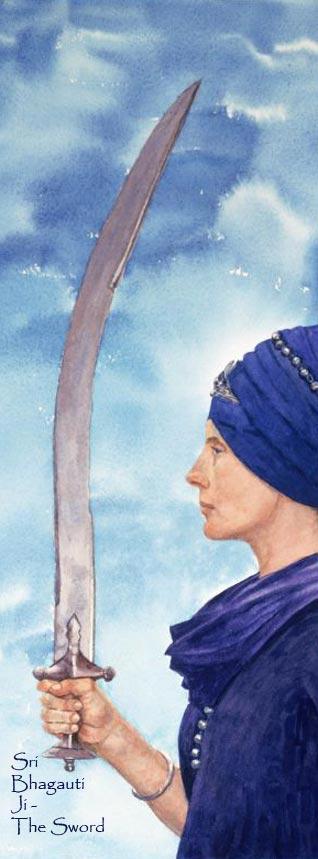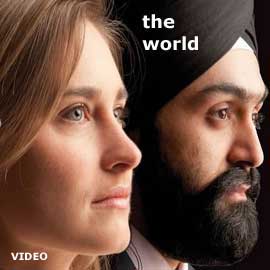Talking Stick
Pritham Bhagauti Simar Ke
Ardaas Part II
The Talking Stick Colloquium # 34, Nov 1 - 7
Convenor: RAVINDER SINGH TANEJA
THE DIALOGUE - So Far
We attempted a brief overview of the Sikh Ardaas by locating its formation and evolution in the context of Sikh history. We also paused and reflected on some of the distinguishing features of our ardaas - remembrance, history, petition and corporate character.
Is ardaas a transaction to be entered for personal gain or a state of mind that is imbued with a sense of deep gratitude and faith? This is a discussion that we hope will unfold in the coming weeks as we delve deeper into the form, structure and underlying philosophy of our institutional prayer.
SUGGESTED STUDY
For the purpose of analyzing the ardaas, one could break it down into its constituent parts. Dr Jaswant Singh Neki in his book suggested the following division:
1 From "Ik Oankar Waheguru Ji ki fateh" to "Sri Bhagauti Ji sahaai."
2 From "pritham Bhagauti simar ke" to "sabh thaa-een hoye sahaai."
3 From "Dasve(n)h Paatsah" to "paatth deedaar da dhyan."
4 From "panjaa(n) pyariaan" to "tinaa(n) di kamaai da dhyan."
5 From "panjaaa(n) takhtaa(n)" to "dhyan dhar ke."
6 From "prithme sarbat Khalsa ji ki" to "Khalsa ji ke bol baaley."
7 From "sikhaa(n) noon Sikhi daan to Dharam ka jaikar."
8 From "sikhaa(n) da mun neeevaa(n)" to "seva sambhaal da daan Khalsa ji noo(n)."
9 From "hey Nimaaniaa(n) de maan" to "di ardaas hai."
10
From "Nanak naam chardi kalaa" to "sarbat da Bhalla."
It may not be possible to dwell on each line of the ardaas - as Dr. Jaswant Singh ji has done in the book. Instead, we will use an abbreviated schema.
THIS WEEK
As was said last week, by overlooking the obvious, we miss patterns, connections and symbolic representations - which, if grasped, could bring a profound shift in our understanding and enable a deeper experience of gurmat.
Add to that the danger of being too literal in one's interpretation. The Gurus did indeed use common currency and colloquialisms to deliver their message - that was their genius - but the common terms they used were invested with a distinct
meaning, which all too often gets lost because we don't see beyond the literal.
Then again, Sikh teachings have used Indian mythology to convey their message. We short change ourselves when, in our eagerness to distance ourselves from our Hindu antecedents, we dismiss all Indian mythology as a waste of time. As a
consequence, we paint ourselves into a corner.
One such example (and the focus of this week's discussion) is the line "pritham Bhagauti simar ke."
ik onkar waheguru ji ke fateh sri bhagautti ji sahaai
vaar sri bhaguauti ji ki/ paatshaahi dasvee(n)
pritham bhagauti simar ke gur nanak laee(n) dhiaae
phir angad gur te amardas ramdaasay hoee(n) sahaai
arjan hargobind no simro sri har rai
sri harkrishen dhiaa-eeay jis ditthe sabh dukh jaae
tegh bahadar simari-ay ghar nau nidh aavay dhaae
sabh thaa-ee(n) hoe sahaai
The invocation to 'Bhagauti' at the start of the ardaas is a passage from Guru Gobind Singh's composition, "Bhagauti ki Vaar," which is one of several works where Guru Sahib has used prevailing mythology to inspire Sikhs into righteous action.
In Guru Gobind Singh's innovative poetic style, we see Waheguru addressed by different names that are inspired by weapons, especially the sword: "Namaskar Sri Kharag ko," or "Sri Asdhuj ji kariyo rachha," or "Sahib sri sabh ko sirnayak."
The use of the term "Bhagauti," which in Hindu parlance is associated with the Hindu goddess Durga, can easily mislead us into believing that Guru Gobind Singh was a Durga worshipper - a claim that is sometimes made by those who wish to
undermine gurmat.
The second stanza of Bhagauti ki Vaar makes it abundantly clear that the term 'Bhagauti' is being used at once for Waheguru, the Creator/ Doer as well as the sword, signifying spiritual knowledge.
The sword is an ancient and widely used symbol to represent the totality of Waheguru's powers. In Bhagauti ki Vaar, the term used is "khanda," which is a double edged sword. The dual edge is very telling since it represents both the creative and destructive powers of the Creator who is actively engaged in the world of its creation, not standing idly by. It also represents transcendence on the one side and its manifestation in the world of time and space.
Above all, the double edged sword as a metaphor for Waheguru signifies justice.
In interpreting the Indian legend of Durga for Sikhs, Guru Gobind Singh is also conveying the inner essence of the story: Durga takes on and kills the demons. The demons, it turns out, represent our own wild inner nature that needs to be creatively
shaped.
LET'S PONDER TOGETHER
a Ardaas or the Sikh prayer is said to be the total outpouring of the individual soul, the ultimate expression of surrender and a reaching out. It is only natural that this outpouring finds a different expression at different times: worship or adoration; thanksgiving/ gratitude; confession; petition; plea for intercession.
We find all of these expressions in gurbani. Yet, it seems that we are reluctant to admit that petitioning (for goods, prosperity, etc.) is prayer.
b The Khalsa as an expression of the principle of justice that is symbolized by the sword.
c What implications does the kirpan have for us? Is it then a weapon or a reminder to be prepared to fight for justice?
November 1, 2010
Conversation about this article
1: Ravinder Singh Taneja (Westerville, Ohio, U.S.A.), November 01, 2010, 1:54 PM.
I found the invocation to Waheguru as Bhagauti very interesting and laden with meaning for Sikhs. If the double edged sword (Khanda) is a metaphor for Waheguru's absolute justice, then the Khalsa becomes an instrument of Waheguru (Akal Purakh ki Fauj) in standing up for justice and equality. This has implications on how we live. I am beginning to think that the kirpan (which I used to think of as a weapon) is really a symbol - a constant reminder that we have to be in a state of preparedness all the time - to fight for justice for all humankind and if that fight means being armed, then that is what we must be prepared to do. Would love to hear what readers think.
2: Balbir Singh (Germany), November 02, 2010, 7:08 AM.
The word 'Bhagauti' occurs three times in the beginning of the ardaas, and also before the names of the Gurus. Why? Are the kirpan and khanda the icons of the Sikhs? Can a plastic sword be used during an ardaas?
3: T. Sher Singh (Mount Forest, Ontario, Canada), November 02, 2010, 7:58 AM.
The word 'Bhagauti' in the ardaas - and in Sikh parlance - stands for the sword, which in turn represents God. Hence, the first invocation in the ardaas is of the Akal Purakh, then of the Gurus. The kirpan and khanda are articles of faith; they represent the idea of the Almighty God in the Sikh Faith, and help us avoid resorting to idols as visual images of God. It's symbolic when you hold it in your hand while saying ardaas. If you understand the symbolism and your mind is truly focused on Waheguru, plastic will do ... or nothing at all will do too.
4: Mohan Singh (Toronto, Ontario, Canada.), November 02, 2010, 7:01 PM.
'Bhagauti' is Bhagwant or Bhagwaan, the prevailing power all over, the Almighty, formless God. The sword (Sri Sahib) is a symbol of shakti (power), also referred to as the kirpan, from kirpa and anakh ('aan'), that is to save (kirpa) others and for self-protection, that is, to maintain anakh. Pritham means first and foremost - referring to Akal Purakh. In 'Akal Purakh ki Fauj', the word fauj represents discipline as in army. A soldier has to wake up early in the morning every day (even on Sundays and holidays) for his parade and maintains total discipline; a Khalsa has to maintain such discipline as a fauji, as Guru Ramdas said: "Guru Satgur ka jo Sikh akhaaye ..." [GGS:305]. Ardaas requires concentration and attention with folded hands as it connects the two hemispheres, touching the center of chest (between the heart and lungs) to create divine vibrations within, which also helps to surrender to God over a period of time, if it is done sincerely and on a regular basis. Apart from the panthic ardaas, one can do a niji (personal) ardaas in the same manner. It is fair to ask for chardi kalaa, sarbat da bhalla, and mental and physical well being, but unfair to do it for material gains, desire or any personal motive. We will be given what we are destined for; prayer will give us strength, tolerance, patience. Guru Arjan said: "Man banchhat fal milley achinta puran hoye kama" - "He effortlessly awards the fruits of the mind's desire, and all works are brought to perfection" - [GGS:614]. There are several shabads in Guru Granth Sahib for such a niji ardaas.
5: Ravinder Singh Taneja (Westerville, Ohio, U.S.A.), November 02, 2010, 9:45 PM.
In the first line, Bhagauti is synonymous with God. The second line refers to the source of this passage, in this case, Guru Gobind Singh's composition - hence "Patshahi 10", and should be recited exactly as it is. The placement of Bhagauti ahead of the Gurus is only natural. I have never seen it held in one's hands during ardaas but it is placed in front of the Guru Granth Sahib.
6: Gurinder singh (Stockton, California, U.S.A.), November 03, 2010, 4:39 PM.
Well explained by T. Sher Singh ji. In many other compositions of the Dasam Granth, Guru Sahib writes in the beginning "Sri Bhagauti Ji sahai", meaning "May The Primal Lord be my support."
7: Gurinder Singh (Stockton, California, U.S.A.), November 04, 2010, 6:30 PM.
In 'Vaar Sri Bhagauti ji ki', Guru Sahib relates the Durga legend thus: that Durga took hold of her Bhagauti (sword) and struck King Sumbh with it. "Durga held out her sword, which appeared like a great lustrous fire; she struck it on King Sumbh and this lovely weapon drank his blood."
8: Yadwinder Singh (Pickerington, Ohio, U.S.A.), November 05, 2010, 5:44 PM.
I think 'Bhagauti' means Akal Purakh, Waheguru. But there is another school of thought, which reiterates that Bhagauti is sword, symbol of power. I personally feel that because the Bhagauti pre-dates the Gurus, so it has to reprsent the super-power, Akal Purarkh.
9: Gurinder singh (Stockton, California, U.S.A.), November 06, 2010, 11:52 AM.
You are right. The Ode is to the Akal Purakh. As T.Sher Singh ji explained, Bhagauti as sword in Vaar Sri Bhagauti Ji Ki, symbolizes Akal Purakh.
10: Ravinder Singh Taneja (Westerville, Ohio, U.S.A.), November 06, 2010, 12:16 PM.
Bhagauti signifies both Akal Purakh and the manifest power that runs through all creation - hence the double edged khanda.
11: Nirmal Singh Nilvi (Texas, U.S.A.), November 06, 2010, 11:59 PM.
Prayer is a fascinating issue and a reflection of the human mind's clever way of creating myths on issues dealing with basic needs and our approach to fulfilling those needs. Our approach to a simple issue of praying, and our convoluted approach in explaining its need truthfully or justifying our approach to that simple truth, is a true reflection of the inner working of the collective human mind's desire to manage complex endeavor of saving the human species from self-destruction, hurting each other and skilfully keep the ugly reality of our true need to pray under wraps.
12: Gurinder Singh (Stockton, California, U.S.A.), November 07, 2010, 10:20 AM.
Same words have different meanings, depending on the context. Thus, at some places "Bhagauti" means a sword, at others, it symbolizes Akal Purakh. On the khanda, Guru sahib writes in Chandi di Vaar: "Khanda pritheme saaj ke jin sabh sansar upaya" - "The Lord first created the double-edged sword (khanda) and then this mortal world." In my view, this means that Truth and Justice precedes all.
13: Yadwinder Singh (Pickerington, Ohio, U.S.A.), November 07, 2010, 11:25 AM.
I think the khanda has a different symbolic meaning in the Sikh faith, which does not relate with the word 'Bhagauti'. The Sikh Khanda is a powerful symbol of the Faith and represents four different aspects: the central double-edged sword, also called the Khanda, signifies divinity, strength, truth, freedom, justice and God's creative power. The Chakkar, the circular form. reprsents the Oneness of God, never beginning and never ending - like a circle, and the oneness of humanity. It reprsents Gos itself. The two crossed swords are of Miri and Piri which represent the balancing of social obligations and a spiritual life-style.
14: Pritam Singh (Surrey, British Columbia, Canada), October 13, 2016, 8:01 AM.
Being a Sikh I'm ordained not to worship idols and symbolism so I would take Bhagauti as Waheguru and nothing else. Guru Nanak showed us the way.



